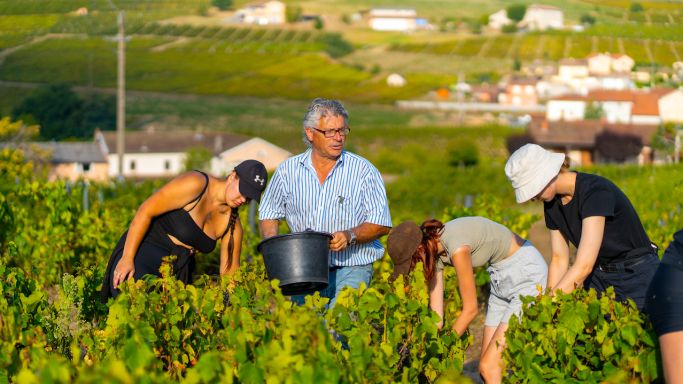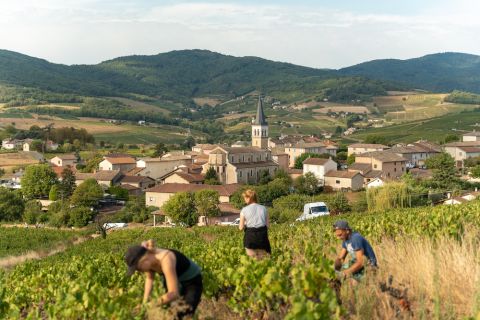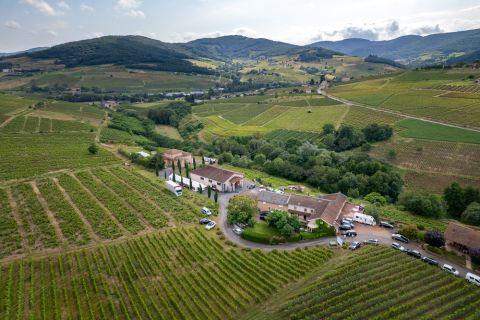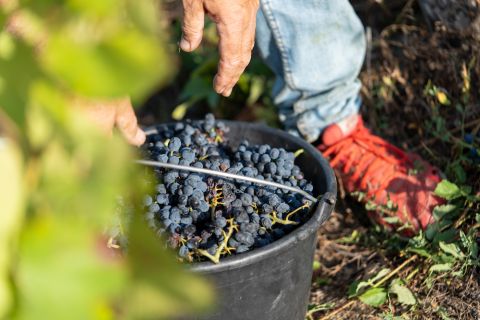A deliciously deep, sultry beaujolais that's irresistible now but could age well, too, starting at $23.99, £19.95.
Of the Beaujolais crus, it’s Morgon that has the reputation of producing the fleshiest, densest, ripest wines. So perhaps I shouldn’t have been surprised when I first tasted Jean-Paul Dubost’s La Ballofière and encountered a welter of purple-black fruit, so sweet and intense that I checked to make sure I hadn’t picked up a bottle of Salice Salentino by mistake. But going back to the wine, I realised that the Morgon minerality – a sense of something dark and gleaming and black – was very much there, like calligraphic punctuation, curling around the playful insouciance of the fruit, turning wine gums and violet candy into something a lot more serious. That was the 2020. When the 2021 landed on my desk, I was more prepared.
Or not quite. I’d forgotten just how seductive this wine’s combination of wickedly sweet, dark fruit and smokily dark, graphite-scented minerality was. It’s the sound of Amy Winehouse, turned liquid and poured, slowly, into a wine glass. You wonder if one sip will stain your lips purple for days. You wonder if you should paint your fingernails black before pouring it. ‘Morgon gone AWOL … It’s outrageously, rebelliously, dangerously delicious. Is it legal for Morgon to taste this seductive?’ was what I wrote.
At the time, I didn’t know about Jean-Paul Dubost, who makes the wine, and I didn’t know about his 40-ha (99-acre) domaine with its 80 plots across eight appellations and climats of Beaujolais, all farmed organically. I didn’t realise that, despite what the wine tasted like, he’s not some kind of new-wave young-gun revolutionising Morgon with a speakeasy, jazz-throaty interpretation of Beaujolais’ most important cru. He’s the head of a family domaine that has been making serious beaujolais since the 1960s, and he took over from his father in the mid 1990s. This particular cuvée comes from a 1-ha (2.5-acre) parcel right at the top of the Morgon appellation at 350–370 m (1,150–1,210 ft), facing west to south. The vines average 70 years old and after the grapes have been hand-picked, the whole bunches go into tanks for spontaneous fermentation and semi-carbonic maceration. 30% is aged in 500-litre barrels for about 10 months. Dubost has always been of the school of using minimal sulphite additions – he has a couple of wines in his range with zero added sulphites, but most are made with the pragmatism of someone who doesn’t want to interfere with the transmission of terroir to glass but doesn’t subscribe to ultra-low-intervention dogma. His aim is to make wines that are delicious to drink but have the structure to age, and La Ballofière bears witness to that.
It tastes so deep-violet-velvet and succulent that it’s hard to believe it’s only 13.5%. It tastes so good that anyone would be forgiven for not taking it seriously (serious wines should be challenging to drink, right?). I’d like to tell you that having tasted it, I then eked it out over several days, trying various food pairings that I could studiously report back on. But the truth is that I handed a glass to my husband and commanded, ‘Taste this!’ And then I handed a glass to the friend who uses our barn for his artisan pizza business (who happens to pop in to say helloooo around glass-of-wine-o’clock), and commanded, ‘Taste this!’ A couple of hours later the bottle was empty. Oops.
It’s the kind of wine you could age, and if you can buy a case, drink a bottle every year, just for the pleasure of watching the wine evolve year after year. But if you’re buying only one bottle, drink it now! It’s just delicious, right now. I failed you on the food-pairings research, but I’d go with dishes that have dark, sweet undertones. I’ve got a caponata on our stovetop right now which has been simmering on low for more than 36 hours and is shiny with peppery olive oil, unctuous with slow-cooked eggplant/aubergine, densely sweet with red peppers and raisins. I reckon this wine would handle this rich, silky, flavour-drenched dish. It would be beautiful with seared duck breast. It would be great with a Parmesan-threaded, umami-dense, wild-mushroom risotto. Or, like us, you could sit around the kitchen table and soak up every dark-blue, kohl-lined, fruit-saturated sip with people you love spending time with.
The 2021 vintage of this wine is available in the US through Rosenthal Wine Merchant and in the UK from Vin Cognito and Carringtons. But other vintages, which I would gladly vouch for, are available in France, Italy, Belgium and Australia.
The JR team love beaujolais. You can find the wines we rate in our tasting notes database and read our articles.
The photographs are reproduced thanks to the kind permission of Domaine Jean-Paul Dubost.






